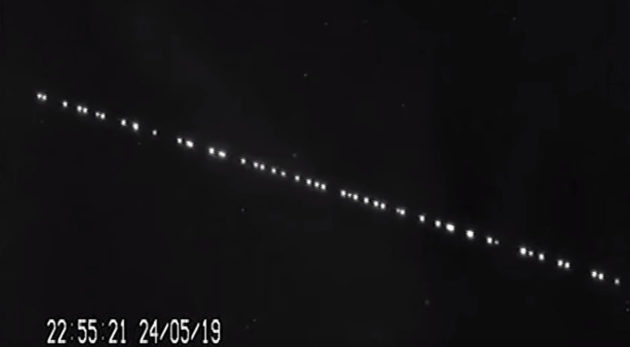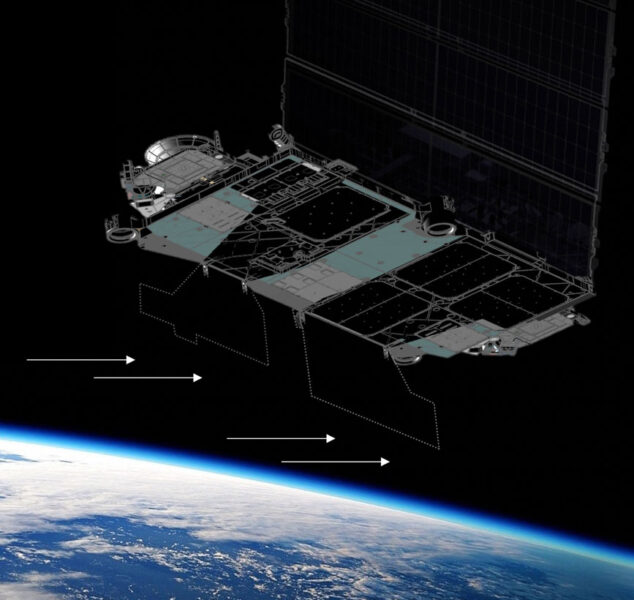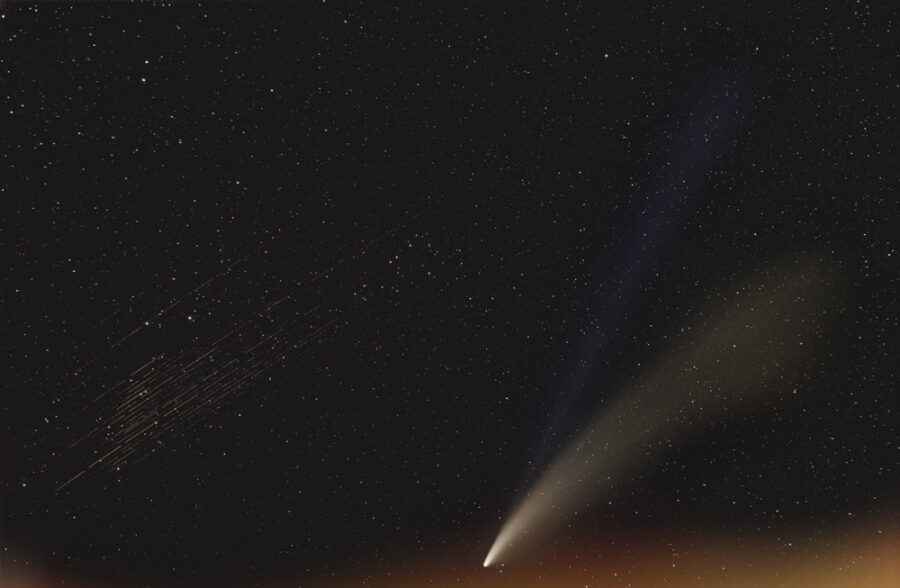Measurements of Starlink’s “VisorSat” show SpaceX has succeeded in making a less reflective satellite. But it’s still visible from dark-sky areas.
The first launch of Starlink satellites two years ago alarmed many amateur and professional astronomers. Lone satellites coursing through the night sky are commonplace, but in May 2019 observers witnessed an unprecedented parade of startlingly bright objects marching across the heavens.

Marco Langbroek
That batch was the first of the currently more than 1,000 satellites that aerospace company SpaceX lofted into low-Earth orbit (LEO). In order to provide space-based broadband, SpaceX plans an initial “constellation” of 1,548 Starlinks, but ultimately it aims to fill out a network with as many as 42,000 spacecraft. Researchers and stargazers alike are afraid that Starlink — and the many other planned satellite constellations like it — might ruin dark skies everywhere.
To the company’s credit, SpaceX is attempting to address astronomers’ concerns. An initial attempt at dimming a Starlink (dubbed “DarkSat”) by painting parts of it black resulted in thermal issues.
A second attempt involved a sunshade, a visor-like appendage that reduces the sunlight reflected to observers on the ground. The first so-called VisorSat launched on June 4, 2020, on the seventh operational Starlink launch. Since the ninth such launch, on August 7, 2020, all Starlink satellites have been VisorSats.

SpaceX
Along with the hardware change for VisorSat, SpaceX also altered the relative orientation of the orbiting satellite bodies and solar arrays to further diminish their brightness. This change in software was instituted on all operational Starlinks.
To read more about the recent meeting of industry leaders and astronomers, see “Beyond Starlink: The Saga Continues.”
I have been studying observations of original Starlink and VisorSat satellites in order to compare their brightness. The observations discussed in this article are of the satellites at their operational altitude at 550 km, not of those still raising their orbits.
Some of the data are generated by visual observers who report their observations to the SeeSat-L email archive. They determine magnitudes in much the same way that amateur astronomers estimate the brightness of variable stars. That is, the satellites are compared to nearby reference stars of known magnitudes. The distribution of magnitudes recorded by visual observers is shown in Figure 1.

Anthony Mallama
The other source of data is an automated observatory in Russia called Mini-MegaTORTORA (MMT). The imaging system is a 9-channel wide-angle sensor consisting of 71-mm-diameter f/1.2 lenses and 2160 x 2560 sCMOS detectors. Satellite magnitudes are posted on their online database. The magnitudes the MMT has measured are a close match to the visual magnitudes reported by human observers.
Starlink satellites are nearest when passing directly overhead at a distance of 550 km, and thus generally the brightest, while those observed toward the horizon are farther away and correspondingly fainter. To account for differences in distance, I adjusted all observed magnitudes to the apparent brightness that would be measured at 550 km. The average of these adjusted magnitudes provides a characteristic brightness for satellites passing overhead.
So far I have collected more than 1,000 magnitudes of original-design and VisorSat Starlink satellites. The average magnitude of the originals at 550 km is 4.63, so they would be visible under even moderately light-polluted skies. The average VisorSat magnitude is 5.92, so they’re only 31% as bright as the originals and significantly more difficult to see.

Alessandro Carrozzi / S&T Online Photo Gallery
Another aspect of Starlink that affects their visibility is the variation around the average brightness. Even after accounting for differences in distance, there is still a dispersion in the observed magnitudes on the order of one magnitude, likely due to the complicated reflecting properties of these satellites' many surfaces. In any case, while the average magnitude for a VisorSat seen at zenith is around 6, the typical spread of individual magnitudes ranges from about 5 to 7. Therefore, an observer under dark skies will see some VisorSats, while others will pass by unnoticed.
In addition to the planned observations summarized above, satellite observers have reported unexpected flares of Starlink satellites that briefly increase their brightness — occasionally by 10 magnitudes or more. Thus, they sometimes exceed the brightness of the most brilliant planet, Venus. Most of these flares were reported early in 2020 on the SeeSat-L email archive. It is encouraging that no extremely bright flares have been reported since that time. The sunshade and adjusted orientation of the satellites are likely reasons for this improvement.
Another factor that limits the adverse impact of Starlink satellites is that, because of their low orbit, they are not all reflecting sunlight during the darkest part of the night. Furthermore, Earth shadowing makes satellites less visible in the eastern sky early at night and less visible in the west before dawn. So, theoretically anyway, observations can be scheduled by time and by sky region in order to avoid satellites.
Starlink satellites will continue to be a distraction to observers for now, but the significantly dimmer VisorSats represent a marked improvement. It remains to be seen if and how other satellite companies will take note and follow suit.
 19
19









Comments
John
January 22, 2021 at 4:50 pm
8-9th magnitude, huh! Wonderful! That's maybe a 2 second exposure for me...What good is all that space junk actually going to accomplish? NOTHING!
SpaceX is out of control but they obviously paid off someone.
You must be logged in to post a comment.
Andrew James
January 22, 2021 at 8:24 pm
110% agree. The imposition is disgusting. 5% of the elites benefit, the rest of the world is punished. All the astronomical community across the world is being dictated to by stupid selfish decisions by FCC. Every observations of the sky, every image or story increases my indignation towards America. Worse I cannot do anything to stop it.
You must be logged in to post a comment.
eddiestardust
February 6, 2021 at 2:09 pm
Andrew, with a degree in Poli-Sci, I of course can tell you as most Americans can, that the FCC is not the "space administration" but NASA is...Fact is that Congress should be doing something and it has it's collective head somewhere else...being vindictive...which is not solving our economic crisis or our pandemic and sure as heck isn't addressing Musk's eccentricities....
You must be logged in to post a comment.
Andrew James
February 8, 2021 at 4:39 pm
Quote “For their first 1,584 satellites, SpaceX has FCC approval for 24 orbital planes of 66 satellites each.” is true, then the problem is really down to the Federal Communications Commission (FCC). This is a wholly US agency, whose goal is: “make available so far as possible, to all the people of the United States, without discrimination on the basis of race, color, religion, national origin, or sex, rapid, efficient, Nationwide, and world-wide wire and radio communication services with adequate facilities at reasonable charges.” (Five elected US politicians.)
Approval has nothing to do with NASA, because NASA has to ask the FCC to launch American satellites.
You must be logged in to post a comment.
John-Murrell
June 13, 2021 at 4:31 am
As was stated at the AAS238 meeting it is not only the public who want world wide high speed internet a lot of the scientific community want to high speed internet to remote data collection facilities, on land, at sea and in some occasions in the air.
Then there is the military interest in the system for communications in difficult to reach areas with little or no connectivity.
I bet the science stations in Antarctica will use the system as well.
You must be logged in to post a comment.
Brocke
January 22, 2021 at 4:58 pm
Hello,
thank you for this article.
Has anyone talked to Mr. Murks already how his plans are to remove all his thousands of satellites from space when they are obsolete waste in a few years?
Kind regards, Derek
You must be logged in to post a comment.
patrickg
January 23, 2021 at 10:46 am
IIRC entering a lower orbit and burning up is the disposal method. About as ecologically sensitive as dumping tons of plastic in the oceans but there will be no massive collections of debris to see so... out of sight, out of mind.
You must be logged in to post a comment.
eddiestardust
February 6, 2021 at 2:06 pm
Customer base? Well, as a customer of Verizon I pay around $120 for phone & internet & email ( along with a few other items ) That's a heck of a lot less expensive than what PC Magazine reports that Musk is charging customers now...$499 for router and dish (mine costs nothing) plus a monthly fee of $99. Now please explain to me how some poor African dude is going to come up with that money or a poor country? Look, Musk has said many times in many venues that he intends to pay for his Mars missions with this enterprise. Now , who is Musk helping? Himself or poor folks?
You must be logged in to post a comment.
Tux_299
January 3, 2022 at 6:38 pm
Wow how to miss the big picture.
A village our charity to donate starlink they connect Wi-Fi access points you cover the whole village with it. Now imagine classrooms with the ability to take college courses from American colleges.
I have friends in Rural America that do not have internet access.
You must be logged in to post a comment.
John-Murrell
June 13, 2021 at 4:32 am
It is a condition of their licence that they de-orbit them at the end of their lives - several hundred have already been de-orbited according to the data base
You must be logged in to post a comment.
Anthony Barreiro
January 22, 2021 at 11:10 pm
Thanks for this report. If indignant invective were enough to solve this problem, the satellites would be falling from the sky. The amateur astronomy community needs objective information to have a seat at the grown-ups' table. Thanks for gathering, interpreting, and presenting these data.
You must be logged in to post a comment.
Andrew James
January 23, 2021 at 1:16 am
My apology if my words are 'indignant invective.' Americans have the possibility to change this, while non-Americans seemingly can do nothing. I've contacted both my governmental authorities and the local US Embassy and Consulate General, and was frustrated by glib responses. Mitigation seems a totally hopeless endeavour. In a nutshell, what is distasteful is a foreign corporation decision that affects me directly.
You must be logged in to post a comment.
patrickg
January 23, 2021 at 10:50 am
The customer base is not exclusively American. It is worldwide so to be consistent you must castigate all customers, likely some of YOUR neighbors included.
You must be logged in to post a comment.
Andrew James
January 24, 2021 at 12:10 am
Eh? What has the customer base have to do with it? The FCC, an American governmental authority, gave the approval for all these satellites. No one else approved it. This is a moral issue that affects every county. Moreover there might be better ways to do this. Castigation towards the U.S imposition is appropriate, especially when you signed a treaty in how space should be used. America is directly responsible for its own actions and should be held to account.
You must be logged in to post a comment.
Brocke
January 30, 2021 at 3:39 pm
Thats exactly the point.
They still act like lawless in the wild west.
Outta my way or you're gunned!
And those cavemen feel that they are the crown of creation.
You must be logged in to post a comment.
Anthony Barreiro
January 23, 2021 at 6:58 pm
No need to apologize. Thanks very much for your advocacy efforts.
I've vented my share of indignant invective about these satellites. I live a few freeway exits from Elon Musk's Hillsborough estate, and I don't feel I have much power to change policy. I'm a member of the International Dark Sky Association and I follow their calls for public input. I have sent messages to my congressional representative and senators and the FCC about this. At best I get form messages back thanking me for expressing my opinion.
Objective data and organized action will help.
You must be logged in to post a comment.
IvoryTower
January 23, 2021 at 10:29 pm
I understand the concern for star gazing but just know these are not for the elites. These satellites are for normal people living in the middle of nowhere with little to no internet access. Now it's absolutely fine to be against that just know these will improve the quality of life of many people. Idk what's more important but at least we need to know there are pros and cons to both positions.
You must be logged in to post a comment.
Andrew James
January 27, 2021 at 4:20 pm
That's the spin. Users will still have to pay for the service, and the profits go to the elites. They ain't doing it for love. Governments are elected to look after what is best for all and are capable to intact with other governments to promote good policy. Musk and his corporation has just bypassed this process. Quality of life means nothing if you are prepared to sacrifice your environment. (If anything, always having your face buried continuously in a screen, reduces your quality of life.)
Mitigation is a certainly solution, but as usual, the damage is done after the fact. We are powerless to stop or consider alternative options, especially for non-US citizens.
Note: The problems with elites is they live in ivory towers - separated from reality and still imposing their will.
You must be logged in to post a comment.
Tux_299
January 3, 2022 at 6:47 pm
"Governments are elected to look after what is best for all."
Precisely and the government's think internet access for _all_ its people is very important. Imagine high-speed quality internet worldwide even in the middle of the ocean.
You must be logged in to post a comment.
You must be logged in to post a comment.